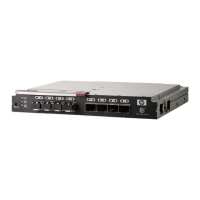Synchronizing local time
To synchronize the local time of the principal or primary switch with that of an external NTP server,
follow these steps.
1. If necessary, log on to the DC04 SAN Director by Telnet, using the admin account.
2. Enter the tsClockServer command as follows:
switch:admin> tsClockServer “<ntp1;ntp2>”
where ntp1 is the IP address or DNS name of the first NTP server, which the switch must be able
to access. The variable ntp2 is the second NTP server and is optional. The operand
“<ntp1;ntp2>” is optional; by default, this value is LOCL, which uses the local clock of the
principal or primary switch as the clock server.
The tsClockServer command accepts multiple server addresses in either IPv4, IPv6, or DNS
name formats. When multiple NTP server addresses are passed, tsclockserver sets the first
obtainable address as the active NTP server. The rest will be stored as backup servers that can
take over if the active NTP server fails. The principal or primary FCS switch synchronizes its time
with the NTP server every 64 seconds.
The following example shows how to change the time zone to US/Mountain.
switch:admin> tsclockserver
LOCL
switch:admin> tsclockserver "132.163.135.131"
switch:admin> tsclockserver
132.163.135.131
switch:admin>
Verifying the Port Identifier mode and connecting to the fabric
Before connecting the DC04 SAN Director to the fabric, verify that the port identifier (PID) mode on
the DC04 SAN Director matches the other switches in the fabric. This parameter must be identical for
all switches in the fabric and is set using the configure command.
To connect the DC04 SAN Director to the fabric:
1. Add SFP optical transceivers (or XFP optical transceivers with FC10-6 port card installed) and
cables to the fibre channel ports.
The ports are color-coded to indicate which can be used in the same port group for trunking.
(Trunking port groups can be up to 8 ports). The ports and cables used in trunking groups must
meet specific requirements. Refer to the HP StorageWorks Fabric OS 6.2.x administrator guide.
2. Position one of the optical transceivers so that the key is oriented correctly to the port. Insert the
transceiver into the port until it is firmly seated and the latching mechanism clicks.
Transceivers are keyed so that they can only be inserted with the correct orientation. If a transceiver
does not slide in easily, ensure that it is correctly oriented.
3. Position a cable so that the key (the ridge on one side of the cable connector) is aligned with the
slot in the transceiver. Insert the cable into the transceiver until the latching mechanism clicks.
Cables are keyed so that they can be inserted in only one way. If a cable does not slide in easily,
ensure that it is correctly oriented.
4. Repeat steps1 through 3 for the remaining ports.
HP StorageWorks DC and DC04 SAN Backbone Director Switches 151

